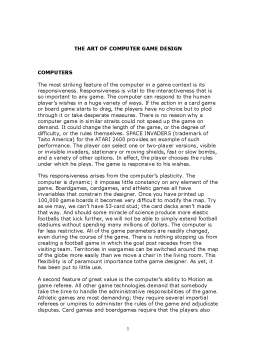Extras din referat
COMPUTERS
The most striking feature of the computer in a game context is its responsiveness. Responsiveness is vital to the interactiveness that is so important to any game. The computer can respond to the human player’s wishes in a huge variety of ways. If the action in a card game or board game starts to drag, the players have no choice but to plod through it or take desperate measures. There is no reason why a computer game in similar straits could not speed up the game on demand. It could change the length of the game, or the degree of difficulty, or the rules themselves. SPACE INVADERS (trademark of Taito America) for the ATARI 2600 provides an example of such performance. The player can select one or two-player versions, visible or invisible invaders, stationary or moving shields, fast or slow bombs, and a variety of other options. In effect, the player chooses the rules under which he plays. The game is responsive to his wishes.
This responsiveness arises from the computer’s plasticity. The computer is dynamic; it imposes little constancy on any element of the game. Boardgames, cardgames, and athletic games all have invariables that constrain the designer. Once you have printed up 100,000 game boards it becomes very difficult to modify the map. Try as we may, we can’t have 53-card stud; the card decks aren’t made that way. And should some miracle of science produce more elastic footballs that kick further, we will not be able to simply extend football stadiums without spending many millions of dollars. The computer is far less restrictive. All of the game parameters are readily changed, even during the course of the game. There is nothing stopping us from creating a football game in which the goal post recedes from the visiting team. Territories in wargames can be switched around the map of the globe more easily than we move a chair in the living room. This flexibility is of paramount importance tothe game designer. As yet, it has been put to little use.
A second feature of great value is the computer’s ability to Motion as game referee. All other game technologies demand that somebody take the time to handle the administrative responsibilities of the game. Athletic games are most demanding; they require several impartial referees or umpires to administer the rules of the game and adjudicate disputes. Card games and boardgames require that the players also function as referees. This is seldom a problem with card games, but it can be a big load with boardgames, especially the more complex ones such as the wargames. Rules disputes and administrative foul-ups are part of the unavoidable dangers of boardgames. The computer can eliminate all of these problems. It can administer the game, freeing the player to concentrate on playing it. This allows one other big advantage: the computer can implement complex arithmetic and logical rules. With other technologies, game rules must be overly simple because the humans implementing them cannot be trusted to perform simple numerical computations. The computer eliminates this restriction.
For example, in the original version of EASTERN FRONT 1941, I was able to use exceptionally complex victory calculations. Most board-level wargames about the eastern front in World War II assign victory points for captured cities, and perhaps for casualties inflicted and sustained. A more complex calculation recognizing the realities of the campaign would be too tedious for human computation. Original EASTERN FRONT 1941 was able to calculate not only cities captured and casualties inflicted and sustained, but also the eastward progress of every German unit as well as the westward resistance of every Russian unit. The game is thereby able to provide a more realistic and meaningful measure of the player’s performance.
The third advantage of the computer is in real-time play. Other game technologies must have pauses and procedural delays while administrative matters are dealt with. The computer is so fast that it can handle the administrative matters faster than the humans can play the game. This makes real-time games possible. Skill-and-action games are the direct result. The speed of the computer also eliminates the need for turn-sequencing so common in card games and boardgames.
Preview document
Conținut arhivă zip
- The Art of Computer Game Design.doc






